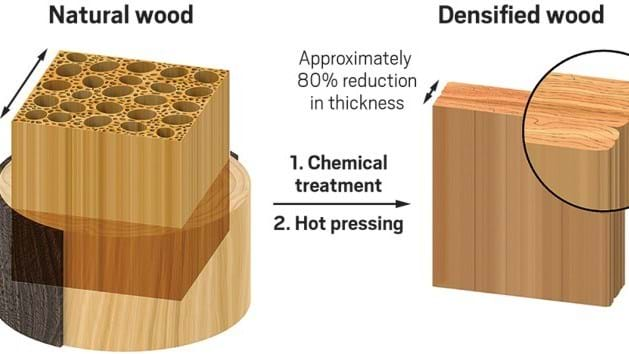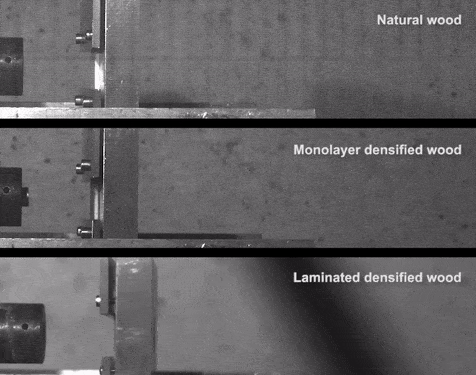New densified wood is as strong as steel

ENGINEERS at the University of Maryland have developed a way to make wood more than ten times stronger, creating a low-cost and lightweight alternative to most metals and alloys.
Strong materials required for construction are usually expensive and can require mining, complex manufacturing processes, and a lot of energy to produce them. Wood is a low-cost, environmentally friendly alternative, but natural wood lacks the strength and toughness for wider use a structural material.
Existing methods for increasing the density of the wood, and thus its overall specific strength, involve treating the natural wood with steam, heat, or ammonia before squashing it to make it denser. These methods result in incomplete densification as some of the pores within the wood are left intact. The wood is only compressed to around 40% of its original thickness and is vulnerable to swelling at high humidity.
Using a new technique for densifying wood, researchers at the University of Maryland have been able to compress wood to 20% of its original thickness resulting in complete densification. The natural wood is first boiled in a solution of NaOH/Na2SO3 which makes it more porous and flexible. The wood is then compressed perpendicular to its growth direction at a temperature of 100°C.
The process involves partially removing hemicellulose and lignin, which is the glue that holds wood cells together. Complete removal of these results in a poor-quality material, suggesting that some lignin is still required to bind the wood. Cellulose is left intact and the hydrogen-bonding between the closely spaced cellulose nanofibers enhance the strength of the densified wood. The densified wood gets slightly weaker and swells at 95% humidity, however an oil-based coating will stop it swelling in high humidity.
The strength of the densified wood was put to the test by firing a bullet-like projectile at it. The laminated densified wood stopped the projectile part way through, while the projectile went straight through the natural and monolayer densified wood.

“It is as strong as steel, but six times lighter,” said Teng Li, co-leader of the research team. “It takes 10 times more energy to fracture than natural wood. It can even be bent and molded at the beginning of the process."
Soft woods, such as pine or balsa, could replace slower-growing dense woods like teak in furniture production and construction. The densified wood also has the potential to replace steel in cars, airplanes, shipping containers, and buildings.
"This could be a competitor to steel or even titanium alloys, it is so strong and durable,” said Liangbing Hu, leader of the research team. “It's also comparable to carbon fibre, but much less expensive."
The technology will be commercialised by the University of Maryland spin-off company Inventwood.
Nature http://doi.org/ckd2
Recent Editions
Catch up on the latest news, views and jobs from The Chemical Engineer. Below are the four latest issues. View a wider selection of the archive from within the Magazine section of this site.




